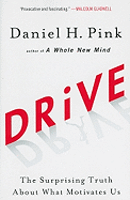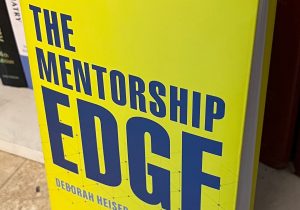Why You Should Read Drive
This is not the book for anyone wanting a quick hit of external motivation to reach a short-term goal. Daniel H. Pink disdains the easy ways out of carrots and sticks, grades and monetary incentives. Instead, Drive details the theory and implementation of what he calls “Motivation 3.0,” where the reward is the task itself—as long as we can turn the work into play by doing it how, when, and with whom we want, as well as work toward mastery of a skill while we do. Oh, and don’t forget: The work better be meaningful, too.
Sound like a tall order? Compared to the traditional motivators like bonuses and certificates, it is, but as Pink argues, it may be the only way to keep ourselves and the people around us engaged in our increasingly creative and self-directed work lives. For Pink, the three great motivators are autonomy, mastery, and purpose, all of which must come from inside us rather than be imposed by others. In this slim volume, he gives the reader lucid explanations of what he means by each term, evidence for why it matters drawn from psychological and case studies, and examples of its implementation in the real world. These include “20 percent time” at companies like Google and 3M, which gives employees greater autonomy over their tasks and time, or hospital cleaning staff who seek out new areas of mastery like chatting with patients to make their hospital stay less frightening.
Pink’s tips for turning your “Type X” (extrinsically motivated) self or workplace into a “Type I” (intrinsically motivated) one run the gamut from simple to complex. At one end, there’s asking yourself each day if you came closer to mastery of a skill than the day before. At the other, it’s implementing something like Netflix’s vacation non-policy, where the only rule is that employees get their work done, and otherwise can take whatever time off they want.
Pink also explains, again with extensive reference to clinical studies, how mixing external rewards/punishments and internal motivation frequently backfires, as with a Swedish study that showed fewer people donated blood when they were paid to do so. On the other hand, he acknowledges that for routine tasks that don’t involve altruism or require much creative thinking, where people must only “race down an obvious path, the carrot waiting for them at the finish line encourage[s] them to gallop faster.” While he urges readers to follow his methods, Pink has a refreshing lack of myopia about his subject material.
While it isn’t a quick fix, this is the book for anyone wanting to learn—or remind themselves—what really drives us all, so that with even a few tweaks, work can become more fulfilling, successful, and even fun.
Drive: The Surprising Truth About What Motivates Us
Daniel H. Pink
New York: Riverhead Books, 2009






0 Comments